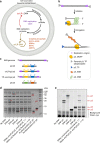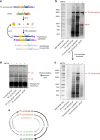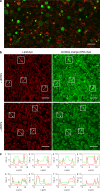Self-replication of DNA by its encoded proteins in liposome-based synthetic cells
- PMID: 29679002
- PMCID: PMC5910420
- DOI: 10.1038/s41467-018-03926-1
Self-replication of DNA by its encoded proteins in liposome-based synthetic cells
Abstract
Replication of DNA-encoded information and its conversion into functional proteins are universal properties of life. In an effort toward the construction of a synthetic minimal cell, we implement here the DNA replication machinery of the Φ29 virus in a cell-free gene expression system. Amplification of a linear DNA template by self-encoded, de novo synthesized Φ29 proteins is demonstrated. Complete information transfer is confirmed as the copied DNA can serve as a functional template for gene expression, which can be seen as an autocatalytic DNA replication cycle. These results show how the central dogma of molecular biology can be reconstituted and form a cycle in vitro. Finally, coupled DNA replication and gene expression is compartmentalized inside phospholipid vesicles providing the chassis for evolving functions in a prospective synthetic cell relying on the extant biology.
Conflict of interest statement
The authors declare no competing interests.
Figures






Similar articles
-
Darwinian Evolution of Self-Replicating DNA in a Synthetic Protocell.Nat Commun. 2024 Oct 22;15(1):9091. doi: 10.1038/s41467-024-53226-0. Nat Commun. 2024. PMID: 39433731 Free PMC article.
-
Terminal protein-primed amplification of heterologous DNA with a minimal replication system based on phage Phi29.Proc Natl Acad Sci U S A. 2011 Nov 15;108(46):18655-60. doi: 10.1073/pnas.1114397108. Epub 2011 Nov 7. Proc Natl Acad Sci U S A. 2011. PMID: 22065756 Free PMC article.
-
Continuous Cell-Free Replication and Evolution of Artificial Genomic DNA in a Compartmentalized Gene Expression System.ACS Synth Biol. 2021 Dec 17;10(12):3507-3517. doi: 10.1021/acssynbio.1c00430. Epub 2021 Nov 15. ACS Synth Biol. 2021. PMID: 34781676
-
Protein-Primed Replication of Bacteriophage Φ29 DNA.Enzymes. 2016;39:137-67. doi: 10.1016/bs.enz.2016.03.005. Epub 2016 May 12. Enzymes. 2016. PMID: 27241929 Review.
-
Liposome-based artificial cells: From gene expression to reconstitution of cellular functions and phenotypes.Biomater Adv. 2022 Nov;142:213156. doi: 10.1016/j.bioadv.2022.213156. Epub 2022 Oct 19. Biomater Adv. 2022. PMID: 36302330 Review.
Cited by
-
Transcription and Translation in Cytomimetic Protocells Perform Most Efficiently at Distinct Macromolecular Crowding Conditions.ACS Synth Biol. 2020 Oct 16;9(10):2797-2807. doi: 10.1021/acssynbio.0c00330. Epub 2020 Oct 5. ACS Synth Biol. 2020. PMID: 32976714 Free PMC article.
-
Reconstitution and Coupling of DNA Replication and Segregation in a Biomimetic System.Chembiochem. 2019 Oct 15;20(20):2633-2642. doi: 10.1002/cbic.201900299. Epub 2019 Aug 28. Chembiochem. 2019. PMID: 31344304 Free PMC article.
-
De novo synthesized Min proteins drive oscillatory liposome deformation and regulate FtsA-FtsZ cytoskeletal patterns.Nat Commun. 2019 Oct 31;10(1):4969. doi: 10.1038/s41467-019-12932-w. Nat Commun. 2019. PMID: 31672986 Free PMC article.
-
Investigating Prebiotic Protocells for A Comprehensive Understanding of the Origins of Life: A Prebiotic Systems Chemistry Perspective.Life (Basel). 2019 Jun 7;9(2):49. doi: 10.3390/life9020049. Life (Basel). 2019. PMID: 31181679 Free PMC article. Review.
-
Microrail-assisted liposome trapping and aligning in microfluidic channels.RSC Adv. 2024 Jun 5;14(25):18003-18010. doi: 10.1039/d4ra02094d. eCollection 2024 May 28. RSC Adv. 2024. PMID: 38841399 Free PMC article.
References
Publication types
MeSH terms
Substances
LinkOut - more resources
Full Text Sources
Other Literature Sources
Molecular Biology Databases

